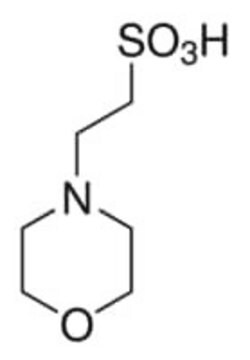M5057
MES sodium salt
BioReagent, ≥99% (titration), crystalline
Synonym(s):
2-(N-Morpholino)ethanesulfonic acid sodium salt, 4-Morpholineethanesulfonic acid sodium salt
About This Item
Recommended Products
product line
BioReagent
Quality Level
Assay
≥99% (titration)
form
crystalline
pH
8.9-10.1 (1% in water)
useful pH range
5.5-6.7
pKa
6.1
solubility
water: 0.5 g/mL, clear, colorless
application(s)
diagnostic assay manufacturing
storage temp.
room temp
SMILES string
[Na+].[O-]S(=O)(=O)CCN1CCOCC1
InChI
1S/C6H13NO4S.Na/c8-12(9,10)6-3-7-1-4-11-5-2-7;/h1-6H2,(H,8,9,10);/q;+1/p-1
InChI key
IRHWMYKYLWNHTL-UHFFFAOYSA-M
Looking for similar products? Visit Product Comparison Guide
Related Categories
General description
Application
- To achieve the required density and stretching of DNA fibers during melting of agarose plugs containing genomic DNA
- To equilibrate the Balch homogenizer chamber and to prevent sample hydrolysis before sample homogenization
Preparation Note
Other Notes
Not finding the right product?
Try our Product Selector Tool.
Storage Class Code
13 - Non Combustible Solids
WGK
WGK 1
Flash Point(F)
Not applicable
Flash Point(C)
Not applicable
Personal Protective Equipment
Certificates of Analysis (COA)
Search for Certificates of Analysis (COA) by entering the products Lot/Batch Number. Lot and Batch Numbers can be found on a product’s label following the words ‘Lot’ or ‘Batch’.
Already Own This Product?
Find documentation for the products that you have recently purchased in the Document Library.
Customers Also Viewed
Our team of scientists has experience in all areas of research including Life Science, Material Science, Chemical Synthesis, Chromatography, Analytical and many others.
Contact Technical Service








